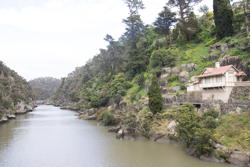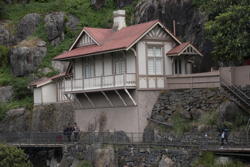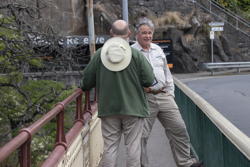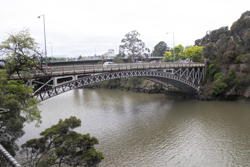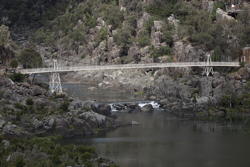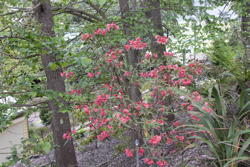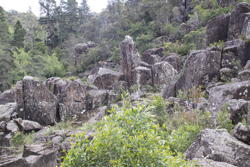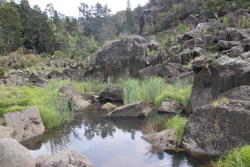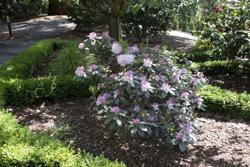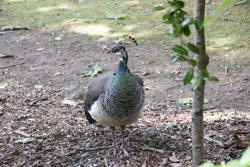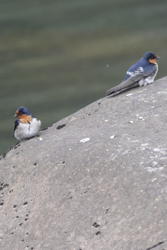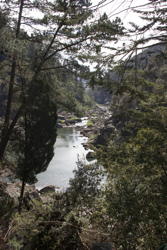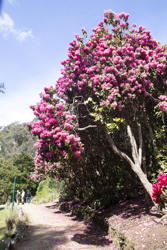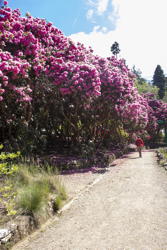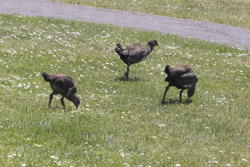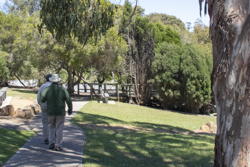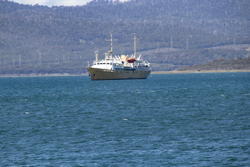
|
|
iPhone panorama, taken at half past noon, the River Tamar
in the background. (Scroll to the right to see the whole picture.) |
Wednesday, 14 November:
Echidnas and Platypuses, Oh my!
At 7:30, John picked us up for a day of sightseeing around Launceston. We started out with a bit of walking around to see the Cataract Gorge of the South Esk River. There’s a scenic walk along the left bank, guarded by a toll station for charging the walkers, when the trail was first established, that doubled as residence of the toll-taker.
King’s Bridge spans the South Esk, and evidently it was considered an engineering and artistic achievement. A second span was built relatively recently, to match the older span in all ways, for reasons of aesthetic harmony.
John drove us upstream to the First Basin, which we walked around. Lots of things to see, flowering shrubs, jagged rockinesses, a couple of magnificent tree Rhododendrons, and more, as you see below. (Don’t forget that when the thumbnail’s border is orange as opposed to the usual brown, you can get a close-up view by passing your mouse over the image.)
From there, we drove along the left bank of the Tamar River and got lots of good views, such as the panorama at the top of this page. As I recall, we stopped at least once in the hope of getting a view of platypus in its natural environmant: John told us that though they are very rare on the mainland of Australia, they can be found in almost every unpolluted river and stream of Tasmania.
One sight that caught the eye of both Mark and me was a little group (too few to be called a flock) of Tasmanian native hens, which are not any kind of chicken at all, but a species of rail, Tribonyx mortierii, completely flightless. I didn’t realize when we spotted them that there was a white patch behind the breast, and only one of my pictures showed this at all well. The ever-reliable Wikipedia says that they are doing very well, not what you’d expect for a small flightless bird, because they like the open fields characteristic of agriculture.
And then there was the big event of the day, a visit to the Platypus House, a great tourist attraction that shouldn’t be missed, if you’re ever going to Tasmania.
| A 7-second clip of one of the females swimming. Notice that they don’t use their tail. |
| A much longer clip, ∼35 seconds. |
While we were here watching the antics of the platypuses, we got all sorts of useful, well interesting, information about the animals. It turns out, for instance, that the males have a spur that conveys a very poisonous toxin. Worse, each individual platypus’s venom is distinctive, so that there’s no way that an antivenin can be developed. So watch out if you’re handling these boys! Apparently, it won’t kill you, but will put you in agony for up to a couple of months. There may be long-lasting side-effects, too.
Next we went around the corner where there were a number of Echidna under study and in display. Whereas the platypuses were completely isolated from the tourists, these little guys were permitted to come out and walk among us. We were told to be quiet and move slowly, but they seemed rather fearless.
|
A very short (13-second) clip showing why the generic name of
the Echidna is Tachyglossus, “swift tongue”. But the movie at the bottom of Mark’s page for this day is much better. |
| A longer (45-second) clip showing the amusing behavior of the Echidnas around people. |
After leaving the Platypus House, we had a nice sight-seeing drive, crossing the Tamar on the Batman Bridge, and then going back to Launceston by back roads. John certainly showed an excellent knowledge of this countryside, taking us through scenery we never would have seen if we had been driving on our own over the main roads.
My journal describes the rest of the evening: «Return in time for dinner at Hallams, where I had a half-dozen oysters and tempura white fish, which I was disappointed to see was just a fancy fish and chips. The fish was a little mushy, not at all flaky. The oysters, though, were top-notch.
«And then to bed.»
And then to dream of next day’s adventure.
